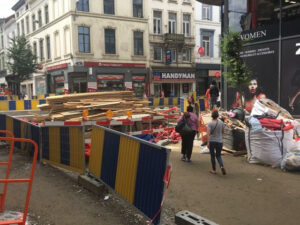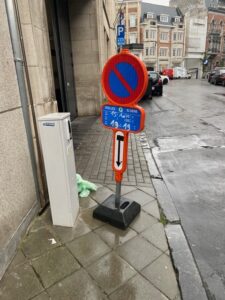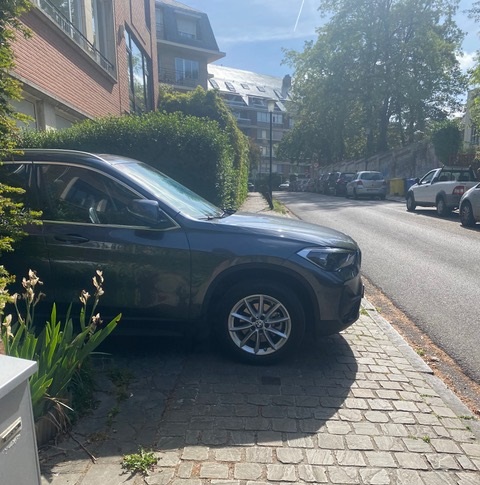Long-time resident and new Belgian Gareth Harding shares his thoughts about life in Brussels and Belgium
The Brussels government recently launched a campaign to encourage people to walk more in the capital. The aim is laudable - walking is safe, good for your health, doesn’t damage the environment and helps create more convivial cities. The publicity was pretty snazzy too, featuring slogans poking fun at mobile phone ads - “feet are free and rechargeable everywhere” - and videos boasting that feet are “made from 100% raw materials and are available 24/7.”
However, the reality of walking in Brussels is a lot less glamorous, with pedestrians forced to swerve around a dizzying array of obstacles as if playing a perverse game of sidewalk slalom. Here are the seven worst sinners:
Cars and vans
Parking partially on the pavement is bad enough for pedestrians, who are forced to squeeze into the gap between buildings and vehicles. But a special place in hell is reserved for drivers who park completely across pavements - because their cars are too big or they can’t be bothered to put them in garages. Drivers of white vans, who think they have a divine right to squat on sidewalks because they’re doing construction work, should also face serious questioning when arriving at the Pearly Gates.
Paving
Walking the streets of Brussels is like walking across a non-lethal minefield - you just never know when a wobbly paving slab will explode with water or a crooked cobblestone will send you sprawling. Then there’s the dog shit. In addition to looking up to avoid bumping into another pedestrian staring at their mobile phone, you also have to look down to avoid putting your foot in a steaming pile of dog poo.
Construction

If you like building sites you’ll love Brussels. Credit G.H
If you like building sites you’ll love Brussels, because sometimes it seems like the whole capital is under construction. In most other cities, sites are cordoned off to prevent passers-by stumbling into cement mixers. But in Brussels, a city that loves to create rules but not enforce them, there are rarely such barriers. So pedestrians have to dodge workers digging holes and scything stones and in flagrant breach of health and safety laws.
Restaurants
There is nothing nicer than drinking and eating on a sunny bar or restaurant terrace in summer. However, this shouldn’t come at the expense of pedestrians, who are often forced to wind their way through open-air eateries, which spill over sidewalks. This is especially egregious on Place Luxembourg, where impressively wide cobbled pavements are chock-full of tables and chairs - even in winter when heated canopies effectively privatise public space.
Signs

Don’t park your signs on the pavement. Credit: G.H
Brussels is famous for its surreal displays of street signs that pepper the pavements like performance art. Whether temporary traffic warnings, road work deviations, restaurant billboards or shop banners, these signs turn walking into an obstacle course for people with pushchairs, in wheelchairs or who are visually impaired. Most of them should be removed or placed in parking spaces. And authorities should issue spot fines to those flouting rules for commercial gain.
Bins
Bruxelles-Propreté, the capital’s waste management service, last month launched a glitzy campaign encouraging residents to put their rubbish on the pavement. This is precisely the problem. Trash bags, whether white, green, orange, blue or yellow, don’t belong on pavements - where they are an eyesore, stink in summer, are ripped apart by cats, dogs and foxes and blown all over the sidewalk when winds pick up. They should be placed in large containers, like in most other European cities. And these containers should be placed on streets, not pavements.
Scooters
It’s great that Brussels has so many rental bikes and scooters to whizz around the city on. What’s not so great is they are scattered across sidewalks when not in use. City authorities have pledged to crack down on scooter sprawl, but until there are fewer providers and more structured parking places, they remain a stumbling block for pedestrians.
Walking is the most popular mode of transport in Brussels, with 37% of all trips made by foot. Most of the time, it’s a delight to saunter the cobbled sidewalks of Brussels, marvelling at the beauty of buildings, bumping into friends and ducking in and out of shops, bars and restaurants without worrying about parking.
But if the city government wants to meet its target of having half of all trips made by foot and bike by 2030, it’s going to need a lot more than publicity campaigns. Together with police forces and local councils, it should clamp down on rogue parking on pavements, on signs scattered across sidewalks and on the privatisation of public space by bar and restaurant terraces. Authorities should also ban bin bags from pavements and get serious about fixing footloose paving. Only then can they boast about walking being the “cornerstone of this city of proximity” without a hint of irony.
What does Belgitude mean to you? Share your thoughts on Twitter, Facebook and Instagram. You can also follow Gareth on Twitter @garethharding

